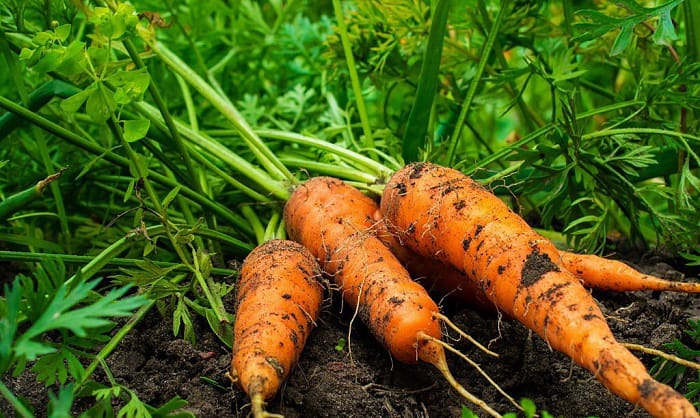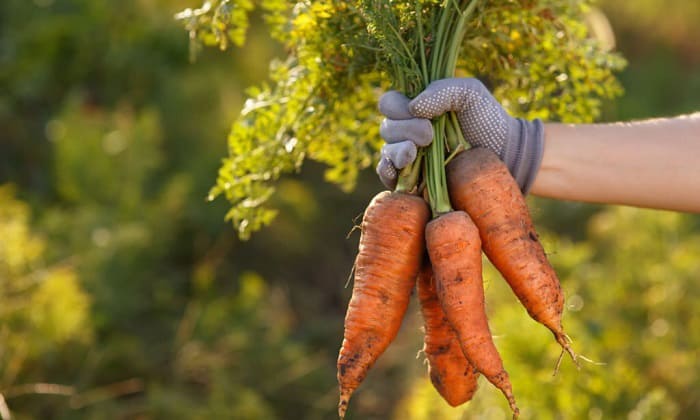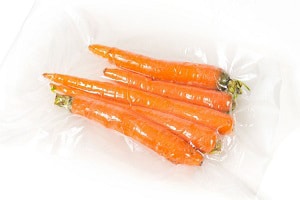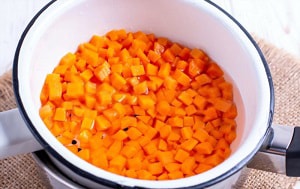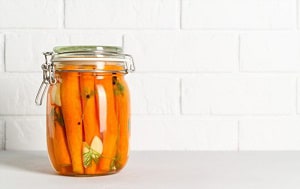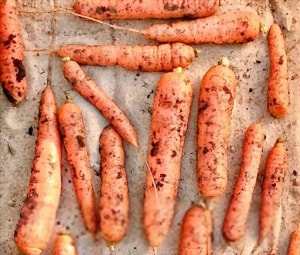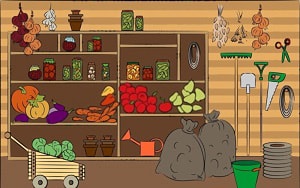We all know that buying carrots in the grocery is more expensive than growing them ourselves.
But what’s challenging about cultivating our carrots is figuring out what to do after planting them. So they stay fresh and last a long time.
Knowledge of properly harvesting and storing carrots in different forms can save your carrots from rottening and preserve their moisture.
I bet you don’t want your labor to go to waste because you don’t know how to store carrots from the garden.
So if you want to know more about this, read on.
Table of Contents
First, Let’s Learn How to Harvest Carrots
Before we learn how to store carrots, we must first learn how to harvest them properly.
Common mistakes of beginner gardeners are that they fail to harvest carrots at the appropriate time and in the proper manner.
What to prepare
- Trowel
- Hand fork
Carrots typically develop 60 to 90 days after planting, so keep an eye on your plants more frequently this time.
Once the carrot tops reach a diameter of ¾ to 1 inch and if their color becomes more vivid, it means that your carrots are ready to harvest.
Here are the steps on how to harvest carrots:
- Step 1: Soften the soil around your carrots using a trowel or a hand fork. It will make it easy to lift your vegetables.
- Step 2: Pull the carrots gently from the foliage.
- Step 3: To keep the taproots moist, cut the foliage off.
Make sure to cut the leaves from the taproot. If not, it takes the sugar taste away from the taproots and draws the moisture away from them, causing the taproots to dry out.
Furthermore, when the foliage rots while still attached to the carrot, it might contaminate the entire carrot.
Ways to Store Carrots From the Garden
1. Storing Carrots in the Fridge
What to prepare
- Kitchen paper
- Water
- Container with lid
The most common way to store carrots after harvest is by placing them in the refrigerator. It keeps the carrots moist and fresh for up to 3 months.
They can be refrigerated in two different ways. The first technique is using kitchen paper. It prevents the carrots from rotting by absorbing the extra moisture they create when stored in the fridge.
- Remove taproot leaves.
- Place a set of kitchen paper on the vegetable drawer in your fridge.
- Put the carrots inside the vegetable drawer.
- Replace the kitchen paper with a new one when it gets damped.
The second method is the use of containers. Sealing carrots while drowned with water inside the container can preserve their solidity.
- Remove taproot leaves.
- Fill the container with water.
- Place the carrots inside.
- Seal the container with its lid.
- Put it in the refrigerator.
- Replace the water every week.
2. Storing Carrots through Home Freezing
What to prepare
- Blanching pot
- Peeler
- Knife
- 1 gallon of water
- Iced water
- Ziplock or container with lid
Storing in freezer is an effective way to store homegrown carrots. It is helpful to preserve your vegetation for up to 12 months.
However, since freezing can degrade the overall quality of any crop, including carrots, blanching is a necessary step in their preservation.
Blanching is the process of scalding vegetables and fruits before freezing them. It protects them from losing nourishment and affecting their physical quality once frozen.
Boiling them in water instead of a microwave is the best way to blanch vegetables and fruits.
These are the steps for blanching and freezing carrots.
- Step 1: Remove the carrot tops and cleanse them with water.
- Step 2: Peel and slice the carrots into small sizes to blanch them quickly.
- Step 3: Fill and heat the blancher pot with 1 gallon of water.
- Step 4: Place the carrots into the blancher pot once it reaches a rolling boil point.
- Step 5: Cover it with its lid.
- Step 6: Let it boil for 2-5 minutes.
- Step 7: After boiling, drain the carrots away from the water.
- Step 8: Place them inside the iced water to prevent them from getting cooked.
- Step 9: Once finished, place them into a ziplock or container with ½ inch headspace and put them in the freezer.
3. Storing Carrots by Canning
What to prepare
- Blanching pot
- Half-liter jar or 1-liter jar
- ½ or 1 tsp of salt
- Dial gauge or weight gauge pressure canner
Putting carrots through the canning process is one of the best options to store carrots long term.
Canning carrots can keep their freshness and quality for up to 18 months. Ensure you know how to properly can them to get your desired results.
Follow the steps below to know how to properly can carrots.
- Step 1: Remove carrot tops and cleanse them with water.
- Step 2: Peel and slice them into small pieces.
- Step 3: Using a blanching pot, blanch the carrots in the boiling water for 5 minutes if you prefer the hot pack method.
- Step 4: Alternatively, slide them into the jars immediately if you favor the raw pack method.
- Step 5: Pack them in a half-liter or 1-liter jar with 1 inch of headspace
- Step 6: Sprinkle ½ tsp of salt into a half-liter jar or 1 tsp into a 1-liter jar.
- Step 7: Fill the jar with boiling water.
- Step 8: Remove the air bubbles.
- Step 9: Put the lids tightly.
- Step 10: Put the jars inside the pressure canner.
- Step 11: Processing pressure: For dial gauge – 11 lbs. Processing pressure: For weight gauge – 10 lbs.
- Step 12: Process the half-liter jar for 25 minutes and the 1-liter jar for 30 minutes.
4. Storing Carrots in Sand Box
What to prepare
- Wooden box
- Moist sand
- Water
If you wish to store carrots without refrigeration, one option is to store them in sand boxes.
This approach can keep your carrots moist and fresh for up to 5 months, allowing you to enjoy them for winter.
The following are the steps for storing carrots in sandboxes.
- Step 1: Prepare a wooden box.
- Step 2: Fill the box with sand that would reach up to 2 inches.
- Step 3: Place a single layer of carrots at a proper distance.
- Step 4: Add another inch of sand to the top of the carrots.
- Step 5: Place the second layer of carrots.
- Step 6: Add another inch of sand on top of them.
- Step 7: Place the third layer and fill it with sand.
- Step 8: Drop a small amount of water on top of the sand to keep its moisture.
- Step 9: Repeat the same process for other sandboxes.
It is important to note that when doing this method, you should try placing them in a cool, dark, and enclosed place. Preferably the basement or inner part of the garage for this to work appropriately.
Regularly inspecting the sandboxes is also necessary to ensure that the carrots are still receiving adequate moisture.
5. Storing Carrots in the Root Cellar or Garage
What to prepare
- Bucket
- Sand or peat moss
Storing carrots in a chilly and dark place like in the root cellar or cool garage is one way to store fresh picked carrots. It can preserve them for up to 6 months.
The optimal carrot storage temperature of 32-38°F is necessary to ensure the freshness and longevity of newly harvested carrots.
Follow these steps to store them using this method:
- Step 1: Once you harvest your carrots, cut their foliage.
- Step 2: Dry them under the sun for two or more days.
- Step 3: Don’t rinse them with water.
- Step 4: Fill the bucket with sand or peat moss.
- Step 5: Place the carrots in a vertical position and with proper distance inside.
- Step 6: Close the bucket with a loose lid to allow suitable air ventilation.
- Step 7: Move them to a cool area of the garage or root cellar.
Helpful Tip
If you want to store carrots in the most economical way possible, you can do so just in the soil where you harvested them.
The most important thing to remember while using this strategy during winter is to pull them as soon as the temperature rises to avoid them dying.
- Dig a trench.
- Place the carrots in the pit at a proper distance.
- Bury them with soil.
- Cover the top with mulch such as straw, hay, and dried leaves.
Conclusion
Although storing carrots is the last step in the cultivation process, it is just as important as planting and harvesting them.
As shown throughout this article, properly storing carrots can help retain moisture, freshness, nutrients, and overall physical quality.
And it’s not that hard to follow any of the abovementioned ways in storing them since you have most of the needed storage and tools in your home.
Try exploring the different methods of how to store carrots from the garden to avoid rottenness and wasting carrots. Thank you!
In addition, each type of vegetable has a different harvest time, read the following articles to find out more:

Hi, I am William – Floridayards’ digital content creator. My job is to find answers to all your concerns with thorough research and our team’s expert advice. I will also bring you honest reviews on the best products and equipment for raising your beautiful garden. Please look forward to our work!


